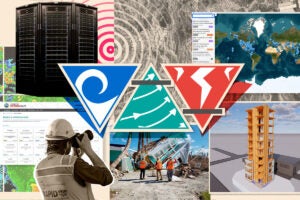AUSTIN, Texas—Small, plasma-fueled satellites designed by aerospace engineering students at The University of Texas at Austin are headed to space after winning a national flight competition.

|
|
The nano-satellite known as FASTRAC (Formation Autonomy Spacecraft with Thrust, Relnav, Attitude and Crosslink) was designed and built in the Satellite Design Lab by a group of about 25 volunteer students and three faculty and advisers, Dr. Glenn Lightsey, Dr. Wallace Fowler and Dr. Laxminarayan Raja.
|
|
Photo: Caroling Lee
|
A University of Texas at Austin team of about 25 multidisciplinary graduate and undergraduate students competed against 12 other university teams in a satellite-building program sponsored by the U.S. Air Force, NASA and the American Institute of Aeronautics and Astronautics. As winners they will receive $100,000 to ready their satellites for flight and a free launch into space in 2006.
Created to encourage smaller, less expensive satellite designs, the contest required entries weigh less than 70 lbs. and cost less than $100,000. The University of Texas at Austin team, supervised by aerospace engineering faculty Drs. Glenn Lightsey, Wallace Fowler and Laximinaravan Raja, began building their satellites two years ago after the sponsors selected their proposal along with those of 12 other universities from an open application process.
The judges said the winning satellites appeared to be the most flight-ready, said Lightsey. The university team had traveled to numerous testing sites in the past few months to confirm their design was viable. When responding to judges’ concerns about the strength or reliability of different features, the students could share test results that assured the features worked.
The future of satellites, said Lightsey, is the use of groups of small satellites that work together instead of a single large one. This offers many advantages: researchers can gradually build a project by sending additional satellites with the same goal. Budgets can be lowered because the probability of mission failure reduces—if one satellite breaks an automatic backup remains in flight.
The University of Texas at Austin team chose to build two smaller satellites that work together to perform their mission. Their project seeks to demonstrate new technology to support these “formation flying satellites.”
They created global positioning satellite (GPS) receivers that allowed the two satellites to communicate with each other in orbit, a new advance in GPS technology. The receivers are used to determine the vehicles’ position and pointing direction. These receivers have been built previously, but using much larger budgets.
They also built a new plasma fuel device. A small satellite has little room for fuel. To address this need, the group developed a device that channels superheated gas through a microscopic nozzle, heating it to a plasma state and creating an efficient method of propelling the satellites and keeping them in orbit.
Finally, they set up a collaboration with other ground stations at Santa Clara University in California and Leeward Community College in Pearl City, Hawaii, in addition to their own station in Austin, Texas, to track the satellites. Using multiple ground tracking sites is unusual, but the satellites will drift apart over time and make them impossible to track from a single site. Using the Internet, the flight team has access to each site and can track the satellites more frequently.
For more information, including a list of participating students, visit the FASTRAC Web site.
For more information contact: Becky Rische, 512-471-7272, or Dr. Glenn Lightsey, 512-471-5322.



